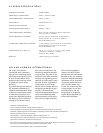
¡ Bias Battery: The bias battery
supplies constant DC bias to the
crossover capacitors, eliminating
crossover distortion at zero electric
potential. Replace the test battery
supplied with your system with a
9-volt, 006P rectangular battery as
soon as possible. Thereafter,
although the speaker will function
without the battery, JBL recommends
that you replace the battery every
two years for best performance.
Access the battery by unscrewing the
cover. Make sure to observe proper
polarity when installing the replace-
ment battery.
™ Network Mode Switch:
This switch should be left in the
“Normal/Bi-Wire” position unless you
are connecting the speaker in a bi-
amp configuration using two power
amplifiers and an external electronic
crossover. Access the switch by
unscrewing the battery cover. The
switch may be adjusted using a flat-
head screwdriver.
£ HF Trim Switch: This switch
allows you to adjust the output of the
high-frequency transducers to com-
pensate for the acoustics of your
room. The +1dB position increases
the output, the 0dB position is a flat-
level position, and the –1dB position
decreases the output. Each position
will affect the tonal balance over a
wide frequency spectrum. Experiment
by placing the switch in each position
while listening to familiar program
material and choose the position that
suits your room acoustics and listen-
ing preferences. You may find that
after a few months, once the trans-
ducers have settled in, that another
adjustment is necessary. This is
normal. Access the switch by
unscrewing the battery cover. The
switch may be adjusted using a
flathead screwdriver.
¢ Mid/High-Frequency Input
Terminals:
For bi-wire or bi-amp
configurations, connect the speaker
wires for the mid- and high-frequency
ranges to these terminals.
∞ Shorting Bars: Leave the short-
ing bars in place only if you are using
the passive single-wire connection
option described on page 15.
Otherwise, remove the bars to pre-
vent possible damage to the speakers
or your electronics.
§ Low-Frequency Input
Terminals:
For bi-wire or bi-amp
configurations, connect the speaker
wires for the low-frequency range to
these terminals.
14
CONTROLS
AND
CONNECTIONS
(–)
(–)
(+)
(+)
High Frequency
Low Frequency
BI-AMP
HIGH FREQUENCY TRIM
+1dB
0dB
–1dB
NORMAL/
BI-WIRE
¡
™
£
¢
∞
§
Figure 9. K2 S5800 controls and connections.
CONTROLS AND CONNECTIONS


















